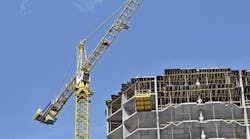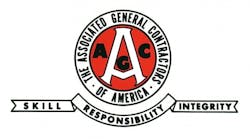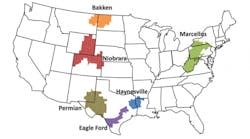Q&A with Ken Simonson
Ken Simonson has been chief economist for the Associated General Contractors of America since 2001. He has 40 years of experience analyzing, advocating and communicating about economic and tax issues.)
RER: What are your expectations overall for the construction economy in 2015?
Simonson: The United States economy, as measured by real gross domestic product, should grow at 2.5 to 3 percent. Construction spending should increase at 6 to 10 percent, vs. 6 percent in 2013, 5 to 7 percent for 2014.
Can you give some insight into the various construction segments?
I expect double-digit percentage increases in oil-and-gas-related construction (drilling sites, pipelines), manufacturing construction, warehouses, hotels, railroads and data centers. Modest increases in single-family, office, retail. A decrease in highway and hospital construction. Little change in retail, office or educational construction.
What about power construction, power generation, and oil-and-gas development?
Gas-fired power plants will do well. Perhaps some growth in transmission lines. Flat or declining spending on other forms of power generation. Despite the big drop in oil prices, still plenty of activity in shale formations rich in natural gas or natural gas liquids.
What prospects do you see for the manufacturing and industry-related construction segment?
Manufacturing will do well thanks to 1) equipment, pipe, rail and other materials related to drilling and transport of oil and gas, as well as plants and export terminals to turn hydrocarbons into saleable products; 2) expansion of assembly and parts plants for all forms of transportation equipment — cars, light trucks, heavy trucks and trailers, rail cars and locomotives, aircraft and barges; and 3) reshoring and new plants, such as Tesla’s “gigafactory” to produce batteries.
Q&A with Ken Simonson, continued
You made this statement in one of your recent releases and I wonder if you can elaborate: “For 2014 as a whole and 2015, private nonresidential spending and multi-family spending should be the strongest segments, followed by single-family construction, with very limited prospects for public construction."
I think millennials are much more inclined to stay in multifamily housing than previous generations, either because they have a preference for “live/work/play” urban locations, are skittish about buying a house after seeing the difficulties homebuyers a decade ago faced in selling (or keeping) their houses, or don’t qualify for mortgages because of higher down-payment requirements or student-loan debts. Public construction is being held down by lagging growth in public revenues and shrinking workforces.
Are there any regions of the country you expect to be particularly strong in construction activity, and any that you feel will be soft?
I expect growth to occur in most of the country and to be strongest in Louisiana, Texas, Oklahoma, and Colorado. Oil and gas is a major part of the reason for growth in each of these states. West Virginia may have the worst prospects because of dependency on coal and federal funds.
In general you expect a positive growth trend for construction activity in 2015. Are there any concerns to watch out for?
If anything, my forecast is too conservative. It’s possible there will finally be the upsurge in single-family sales and construction that other forecasters have been expecting for the past four years. Office and even retail might rebound.
Should companies –- particularly equipment rental companies -- remain cautious about over-spending, over-investing, and becoming over-leveraged or is this a good time to really go for the growth?
I’d be cautious, but then I never expected the Dow Jones Industrial Average to set 30-some records this year.
In the equipment rental industry we notice a trend towards more renting and less purchasing of equipment on the part of contractors? Do you think that trend is likely to continue?
Yes, I think companies remain cautious about committing to ownership in light of how variable the market has been.
Q&A with Dave Zwicke
Dave Zwicke is senior regional analyst for the Portland Cement Association. RER interviewed him about the causes of the shift to multi-family housing, debt pressure on the millennial generation, regional construction trends, strong growth in residential and non-residential construction and the possibility of inflation.
You recently forecasted significant increases in total construction spending for the next few years: 9.2 percent in 2015, 9.8 percent in 2016, 7.5 percent in 2017 and 5 percent in 2018. Do you still stick with these numbers and can you give any background to support them?
Zwicke: 2014 is coming in stronger than we expected, slightly slowing the growth rate for 2015. We’re expecting more multi-family compared to single family.
What makes you predict the shift to multi-family growth rather than single-family?
A lot of it is demographics. The millennials are one major difference; they are a generation coming out of college with a much higher student-loan debt than generations before them. That level of debt slows down the personal home-buying process. We expect them to move more towards renting and for a much longer period of time than we’ve seen in the past. Also there’s some fallout from the last housing boom/bust cycle, during which there were individuals that were foreclosed upon due to hardship or people in the market who financially should not have been homeowners. There’s still that residual and they are returning back into the rental market, which will put more pressure on vacancy rates.
The last component is the aging of Americans. As the boomers get older, there will be more empty-nesters looking to downsize in terms of home size and more second-home purchases such as condos down on the coasts. With older generations we’re seeing an uptick in assisted living communities, which also get captured in the multi-family numbers.
So two generations, the boomers and the millennials, are driving a lot of the multi-family demand and more of a structural shift towards the multi-family than we’ve seen in the past.
You said the private sector drove recovery in 2014. Do you expect the public sector to play more of a role in 2015?
We still expect the residential or the private side to really drive the recovery; it’s definitely the strongest section going forward. But moving into 2015 we expect public to once again be a contributor. The public construction sector has been a drag on the economy, but will start contributing to growth. The level of growth will probably be moderate compared to the private sector but finally, after about six years of decline, we’ll start seeing growth from public, commercial and residential. We’ll see all three sectors contributing to overall construction activity.
You said consumer confidence is at its highest since the recession. What impact does this have on the economy and ultimately on the construction forecast?
Consumer confidence is a very subjective metric, but it’s an indicator for increased future consumption. As individuals start to feel better about their economic situation, they’re more likely to purchase large-ticket items. It’s important to have a consumer that’s both feeling confident and financially healthy to see above-average economic growth, which we’re expecting for next year. To tie it back to the construction side of the market, if consumers are feeling uncertain, they are much more hesitant to make large-ticket purchases such as homes. But with consumer confidence rising, we expect to see increased home sales and appliances and cars and other large durable goods, which are manufacturing-intensive and can also lead to job creation, which in turn leads to more economic growth and increased construction on the non-residential and commercial side.
Consumer confidence essentially is a good proxy for other indicators because it ties into job growth and performance in the financial markets. It’s a good broad metric to give you an idea of how indicators are moving.
Job creation would have the same kind of effect?
They move very closely together and sometimes overlap. Job creation has a very strong impact on the construction sector. When you see an additional job created, that potentially adds a new homeowner, it will lead to demand for new office and industrial space and in the long term helps create a new taxpayer which will help fund infrastructure projects. So job creation has a broad impact on all sectors of the construction industry.
Then more strip malls, roads, schools, and other projects.
Yes exactly. Job growth has grown pretty well in the recovery period, and it’s really starting to accelerate; we expect more the beginning of next year. We expect aggressive rapid expansion of job creation. It leads to more household formation, and household formation has been lacking throughout this recovery. Once we start seeing this more aggressive job growth, we’ll see more individuals move out on their own and expand household formation, which will lead to a stronger uptick in residential construction over the next few years.
You expect an increase in housing starts through 2018 but still not reaching 2005 levels, correct?
We are trying to be conservative. We acknowledge that there is a lot of pent-up demand. We have to build 1.2 to 1.5 million units per year just to maintain with demographics and population growth. We’ve seen double-digit rates of change in the housing market the past few years and we’re still generating more pent-up demand -- so pent-up demand is really the wild card. We’re trying to err on the side of caution and keep the forecast conservative but we acknowledge that there is a possibility that we could pass these levels if the pent-up demand that needs to be generated is released.
But timing when it’s released is a very difficult thing to do, it could be two years, five years, even 10 years, so we’re essentially taking the long route and saying it’s going to be a long steady release of pent-up demand. Therefore that will be a strong tailwind for the housing market for quite a while. But if it does come much sooner, we could see levels towards the end of the forecast rising. But we’re keeping those numbers within reasonable levels compared to past peaks.
Q&A with Dave Zwicke, Continued
How will the construction economy fare on a regional level in the foreseeable future?
The strongest economies have been on a corridor from Texas to North Dakota; that’s been the case for the last few years. They have benefited from high energy prices. In this last recession, they avoided much of the downturn in housing; they weren’t subject to extremes like we saw on the coasts. So in terms of overall health, those are the strongest economies presently and the strongest construction markets. But if you’re looking at rate of growth and rapid expansion, we expect that to come in the Southeast and Southwest. Those markets have favorable demographics and large in-migration. But we saw rapid decline in construction in these markets. So they have much more room to grow back.
Definitely something to keep an eye on with North Dakota is oil prices, it’s still kind of uncertain where oil prices are headed. But of the two, North Dakota versus Texas, Texas is much more diversified therefore you see less of an impact if oil prices do remain low for an extended period of time. There’s more risk in North Dakota where growth has been much more driven by oil exploration. They have fewer downstream oil industries.
In other markets, we expect the Great Lakes to be doing very well but probably lagging the national growth rate a little bit, and that’s because the residential market is slow to recover there. The Great Lakes have the highest concentration of judicial review in the foreclosure process so this market is slower at cleaning out distressed properties that have remained on the market.
The Northeast is at risk of being the weakest of regions. From a construction perspective, it’s a very mature market. There are not dynamic demographic changes in this region, and also there is exposure to Europe, which has been very weak as of late and is running the risk of going into a triple-dip recession. That would have a negative impact on the Northeast. That said, we still expect growth in the Northeast and really throughout the entire country. We expect this recovery in terms of construction to be very broad-based. And we expect an acceleration next year compared to what we’ve seen this year.
The Northwest we expect to do very well. The Southwest and Northwest are similar, but the Northwest doesn’t have the same level of demographic growth. But we think that market is healthy as a whole, slightly ahead of the national rate of growth.
What will be the strongest segments in the non-residential space?
We expect to see growth in all segments. We expect office to be the leader on a percentage growth basis, as well as retail. We feel we are in the early stages of a rapid recovery on the commercial and non-residential side and we expect all those segments to be very strong in rates of growth this year and next year. A lot of it is in job growth, and we’re seeing very tight vacancy rates in many markets, which will help fuel demand for office projects. And we’re seeing resurgence in industrial and the re-shoring of industrial and manufacturing back to the U.S.
And part of that too again is going back to the domestic energy story in the U.S. where we’re seeing energy prices in terms of oil nearing parity with the rest of the globe, and we’re seeing very cheap natural gases relative to most other markets. As a result there is much more incentive for many industries that are energy intensive to return to the U.S. and we think that will help drive industrial manufacturing and construction for the next few years. We’re seeing a lot of housing starts in very dense urban areas, and in the later stage the housing markets move out once again into suburban and ex-urban areas, so we’ll start seeing more increase in retail and strip malls and a lot of retail and restaurants that follow the housing market.
You are predicting solid construction and economic gains over the next few years. Other than unpredictable disasters are there any scenarios or issues that could derail this fairly positive outlook?
There are probably three such scenarios, one near term, one middle term, and one long term. Near term if there are any more political showdowns in D.C., like the government shutdown and near U.S. default a year ago. If that kind of brinkmanship returns, it could lead to a kind of stutter-step economy as it really shakes consumer confidence and the financial markets themselves. More of a middle-term view -- like two, three, four years out -- there is a risk of inflation. If there is a rapid rise in inflation that would cause a response that would mean a sharp rise in interest rates, which could definitely put the brakes on the economy, especially on the construction markets where there is a high exposure to interest-rate sensitivity.
The reason we’re a little concerned for that in the longer term is that right now there’s a lot of liquidity in the markets because of Federal Reserve and monetary and fiscal policies, mostly on the monetary side. But right now there hasn’t been a lot of lending, so even though there’s a lot of liquidity out there it’s not putting any inflationary pressure because we’re not seeing very high levels of lending like we’ve seen in like a pre-boom era.
But if there is a rapid rise in lending standards, there’s definitely some risk of inflation towards the end of the process. But again that’s hard to say, especially now when the Federal Reserve is monitoring that very closely. But three or four years down the road, inflation could be a concern in the case of a rapidly expanding and strengthening U.S. economy.
A long-term issue is debt loads, either student loan debts or public pension debts. Student loan debts would be more like a drag rather than a catalyst for a black swan on the economic side, but if student loan debts continue to rise, we’re stepping on a large component of the population that could be an economic drag that would be persistent for many years. Essentially millennials would have to be paying for present-day purchases, or sacrificing those to paying off past debt. So there could be an economic drag there from the student-loan side. Also there’s some risk from public pension debts longer term, putting an increasing burden on state and local governments. That’s more of a long-term kind of risk.











